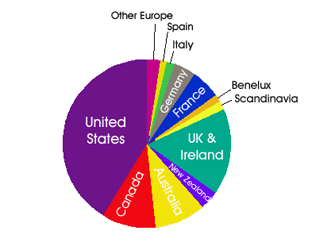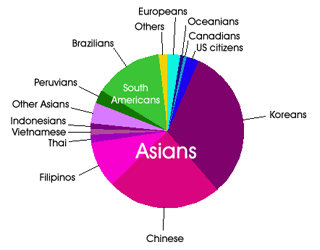Here are some numbers on the 2.2 million foreigners who live in Japan and make up 1.63% of the overall population here. While the classic image of a bumbling American or Brit on a mountain bike asking for directions to the train station might be prevalent in the minds of most Japanese — this is because the foreigners they’ve had the most contact with have been their English teachers — in reality Americans and Europeans make up only a small number of the total. The largest “foreign” group here are Chinese followed by Koreans, and as I mentioned last time, many of these were actually born and raised in Japan but maintain a unique identity for cultural reasons that are beyond my ability to grasp. (Interesting aside for anime fans: Lynn Minmei from Macross would have fallen into this category.) The next largest group are the nikkei (Japan-related) from Brazil and Peru, descended from Japanese who went on a diaspora to South America a century ago. In general, foreigners in Japan each find their own specific niche to occupy, and truth be told, I couldn’t tell you much about the daily lives of people in most other groups. When I was an English teacher, I did English-teacher-type things like go see American movies, explore my city for hidden temples and study Japanese. I did my best to break out of that shell, though, hitting all the Peruvian restaurants the Japanese are too timid to enter, working out with a big guy from Iran for a few months (we communicated in Japanese, always an amusing sight to see), and challenging a Chinese friend to see who could get a higher score on the Japanese Language Proficiency Test. (I beat her score barely.)


Breakdown of foreigners living in Japan by country.















